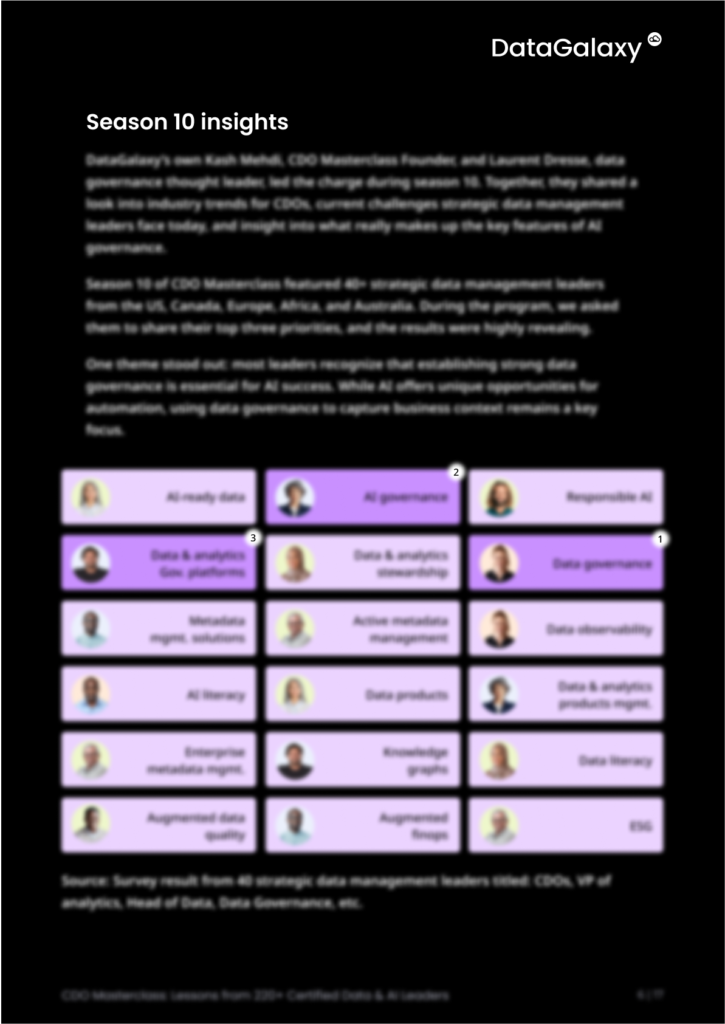
Data observability in 2026: Why it matters, how AI enhances it, and top data observability tools
It’s no secret that ensuring data pipeline accuracy and reliability has become one of the most pressing challenges in modern data operations.
The growing reliance on automated analytics, AI models, and customer-facing applications means that undetected data issues can lead to flawed insights and costly decisions.
Data observability tools help teams monitor the state of their data across systems, providing clear visibility into its quality, freshness, and lineage. These tools make it possible to detect anomalies early, trace their origins, and maintain a high standard of trust in data products.
In this article, we’ll explore Bigeye, Sifflet, and Monte Carlo, the leading data observability tools, and examine how they integrate with DataGalaxy to create a comprehensive approach to data quality, governance, and collaboration.
TL;DR summary
Modern data ecosystems are increasingly complex, making data observability essential for ensuring data quality, trust, and operational resilience. In 2025, data observability enables organizations to monitor data health proactively, support AI governance, and reduce data downtime.
This updated guide explains the key components of data observability, how AI elevates observability practices, the strengths of top tools like Bigeye, Sifflet, and Monte Carlo, and why pairing them with DataGalaxy creates a complete Data & AI Product Governance ecosystem.
When data breaks—whether due to schema drift, missing records, incorrect values, or pipeline failures—the cost can be significant:
- Incorrect insights
- Compromised AI decisions
- Regulatory risk
- Frustrated business users
- Loss of customer trust
This is why data observability has become foundational to modern data operations (DataOps), AI governance, and enterprise data strategy.
When combined with a Data & AI Product Governance Platform like DataGalaxy, organizations unlock true end-to-end control over their data assets, lineage, quality rules, and domain ownership.
What is data observability?
Data observability is the ability to fully understand the health, quality, lineage, and performance of data across an organization’s data stack.
On a more technical level, data observability extends the concept of application observability (logs, metrics, traces) to the data layer, giving data engineers and analysts a way to detect issues proactively.
Core dimensions of data observability
| Dimension | What It Measures | Why It Matters |
|---|---|---|
| Freshness | How up-to-date is the data? | Prevents stale analytics & pipeline delays |
| Schema | Unexpected table/column changes | Detects breaking changes early |
| Distribution | Whether values fall within expected ranges | Finds outliers, drifts, and data poisoning risks |
| Volume | Missing, duplicate, or abnormal record counts | Ensures completeness |
| Lineage | Full trace of data flow and transformations | Enables impact analysis & root cause discovery |
Together, these pillars provide a full picture of data health and ensure teams know when the data is wrong, what broke, and how to fix it.
The importance of data observability
Data observability transforms how organizations manage risk, ensure data quality, and align data operations with business value.
Its importance extends beyond just data teams.
Data observability can help every member of a data-driven organization:
- Trust in data products: A lack of observability erodes user confidence and risks costly errors
- Faster incident resolution: Observability tools help teams detect, triage, and resolve data issues in real time
- Regulatory compliance: Data regulations like GDPR and HIPAA require transparent data handling that can be increased through data observability
- Collaboration at scale: Data observability fosters shared accountability across engineering, governance, and business users
Data observability + AI: A high-value partnership
AI and data observability reinforce each other.
As organizations adopt Generative AI, MLOps, and intelligent data products, the need for high-quality, explainable, and well-governed data becomes urgent.
How data observability supports AI systems
- Protects model training pipelines from corrupted, missing, or drifting data
- Tracks data lineage from ingestion → transformation → model training → inference
- Enhances explainability through visibility into data dependencies
- Reduces bias and strengthens governance
- Improves model stability and performance
How AI enhances data observability
Modern observability platforms increasingly leverage AI for:
- Automatic anomaly detection (no manual rules)
- Predictive alerts before failures impact the business
- Automated root cause analysis
- Real-time monitoring at scale
This synergy creates self-healing, highly reliable data ecosystems—essential for AI safety and operational excellence.
Unlock the playbook of 220+ data & AI leaders
Learn the secrets shared over 10 seasons of CDO Masterclass, DataGalaxy’s premier online and in-person learning experience.
Download the white paper
Top data observability tools in 2026
The market for data observability tools has matured significantly, with several platforms emerging as best-in-class for enterprise needs.
Among the top in 2025 are:
- Bigeye: A proactive monitoring platform for engineering-heavy data teams
- Sifflet: An AI-driven observability suite with native integrations and collaboration features
- Monte Carlo: A pioneer in the data observability space, known for its robust anomaly detection and data downtime prevention
Each of these tools offers distinct strengths, and when used alongside a collaborative data catalog like DataGalaxy, they form a powerful end-to-end data trust ecosystem.
Bigeye
Bigeye is a leading data observability platform tailored for data engineers and analytics teams that need granular, automated insights into data health.
It was originally focused on metrics-based monitoring and has expanded to offer predictive anomaly detection and pipeline-aware alerting.
Bigeye offers several interesting features for users, including:
- 100+ prebuilt monitors: Bigeye automatically detects issues in freshness, volume, distributions, schema changes, and more
- Dynamic thresholds: Learning baseline behaviors and flags deviations without manual rules
- Root cause analysis: Bigeye links anomalies to upstream pipeline events or schema changes
Sifflet
Sifflet brings an AI-first approach to data observability, blending automation, intelligence, and collaboration in a modern UI.
Sifflet is well-suited for data-driven organizations focused on scale and agility, as it has native integrations across cloud data stacks and metadata platforms.
- Multi-layer observability: Sifflet monitors across the storage, transformation, and consumption layers, including working with common tools like Snowflake and dbt
- Built-in collaboration: Users can assign issues, comment on alerts, and track resolution directly in the platform
- Incident management integration: Sync alerts to Slack, Jira, or PagerDuty for streamlined response workflows
CDO Masterclass: Upgrade your data leadership in just 3 days
Join DataGalaxy’s CDO Masterclass to gain actionable strategies, learn from global leaders like Airbus and LVMH, and earn an industry-recognized certification.
Save your seat!Monte Carlo
As one of the earliest entrants in the data observability space, Monte Carlo has defined many best practices in data downtime prevention.
Today, Monte Carlo continues to lead with an enterprise-grade platform that emphasizes coverage, detection precision, and operational maturity.
Monte Carlo users can benefit from the following features:
- Field-level lineage: Users can go beyond table lineage to track data changes at the column level
- Incident Impact Analysis: Monte Carlo quantifies how issues affect downstream dashboards or reports
- Data contracts support: The platform ensures producers and consumers agree on data expectations
Monte Carlo is ideal for large enterprises prioritizing resilience, compliance, and data reliability across complex ecosystems.
Data observability with DataGalaxy
Data observability tools offer in-depth monitoring and diagnostics, but their full value is realized when integrated into a comprehensive data governance and knowledge-sharing framework.
DataGalaxy acts as the central hub of your data knowledge by offering semantic definitions, cataloging, lineage, ownership, and business context.
When paired with observability platforms like Bigeye, Sifflet, or Monte Carlo, the result is a closed-loop system where:
- Alerts from observability tools are linked to datasets defined and governed in DataGalaxy
- Lineage views in DataGalaxy help contextualize alerts within the broader data ecosystem
- Root cause analysis is accelerated by clear ownership and documentation from DataGalaxy’s catalog feature
- Collaboration is enhanced by tagging domain experts, owners, or stewards to triage issues
How DataGalaxy complements observability tools
As the modern data stack becomes increasingly complex, observability cannot exist in isolation. A scalable data management approach requires aligning technical monitoring with business context, governance, and collaboration.
Here’s why DataGalaxy is an ideal partner for your observability stack:
1. Business-first data catalog
Clarifies technical alerts with meaningful business definitions, tags, and contextual metadata.
2. Collaborative data governance
Assigns clear ownership, responsibilities, and escalation paths when issues arise.
3. End-to-end automated data lineage
Shows precisely how data flows across your ecosystem and how an upstream issue impacts downstream dashboards.
4. Knowledge graph to connect all entities
Links datasets, KPIs, domains, and AI products in a living knowledge graph for full visibility.
5. 70+ connectors & open APIs
Integrates metadata and alerts from platforms like Bigeye, Sifflet, and Monte Carlo into unified quality and governance workflows.
6. AI product governance (AIPG)
DataGalaxy ensures AI models, datasets, and transformations comply with governance standards—making observability part of a broader AI trust strategy.
Ask questions. Get answers. Drive action.
Blink bridges the gap between intent and action, pointing users to the right process, definition, or owner. It’s not just search. It’s guided governance, built in.
Meet Blink!Data observability best practices for AI-driven organizations
To maximize the value of observability, leading teams prioritize:
- Establishing clear data quality rules and expectations
- Using automated anomaly detection and alerting
- Continuously auditing datasets and pipelines
- Tracking lineage from raw data to AI products
- Maintaining accurate and collaborative documentation
- Involving data owners, domain leaders, and governance teams in issue resolution
These practices strengthen data reliability while improving AI transparency, fairness, and regulatory compliance.
Final thoughts
To fully unlock the value of trustworthy data, organizations must pair monitoring with collaborative governance, contextual documentation, and shared understanding.
Tools like Bigeye, Sifflet, and Monte Carlo deliver best-in-class data observability, and when integrated with DataGalaxy, they form a robust data trust layer. This helps teams not only know what’s wrong but also understand why it matters and how to fix it together.
FAQ
- What is data lineage?
-
Data lineage traces data’s journey—its origin, movement, and transformations—across systems. It helps track errors, ensure accuracy, and support compliance by providing transparency. This boosts trust, speeds up troubleshooting, and strengthens governance.
- Why is data lineage important?
-
Data lineage is important because it provides visibility into the origin, movement, and transformation of data. It enables regulatory compliance, faster root-cause analysis, improved data quality, and trust in analytics. By mapping data flows, organizations enhance transparency, streamline audits, and support accurate, AI-driven decisions, making it a cornerstone of effective data governance.
- What is data intelligence?
-
Data intelligence transforms raw data into meaningful insights by analyzing how it flows and where it adds value. It uncovers patterns and connections, helping teams make confident, strategic decisions that drive real business outcomes.
- What is DataGalaxy?
-
DataGalaxy is a modern data & AI governance platform that centralizes metadata, data lineage, and business definitions to create a shared understanding of data across the organization. Designed for collaboration, we empower teams to find, trust, and use data confidently. Learn how DataGalaxy accelerates data-driven decision-making at www.datagalaxy.com.
- What makes DataGalaxy different?
-
DataGalaxy stands out with our user-friendly, collaborative data governance platform that empowers everyone—from data stewards to business users—to understand, trust, and use data confidently. Unlike complex legacy tools, DataGalaxy offers intuitive metadata management, real-time lineage, and a business glossary in one centralized hub. Discover how we drive agile, value-first data strategies at www.datagalaxy.com.
Key takeaways
- Data observability is essential for trustworthy analytics, AI, and regulatory compliance.
- AI and observability form a powerful cycle that improves data reliability and model performance.
- Bigeye, Sifflet, and Monte Carlo are the top platforms in 2026.
- DataGalaxy completes the observability ecosystem by adding governance, lineage, ownership, and business context.
- Organizations that combine observability + governance gain a competitive advantage in data-driven decision-making.

